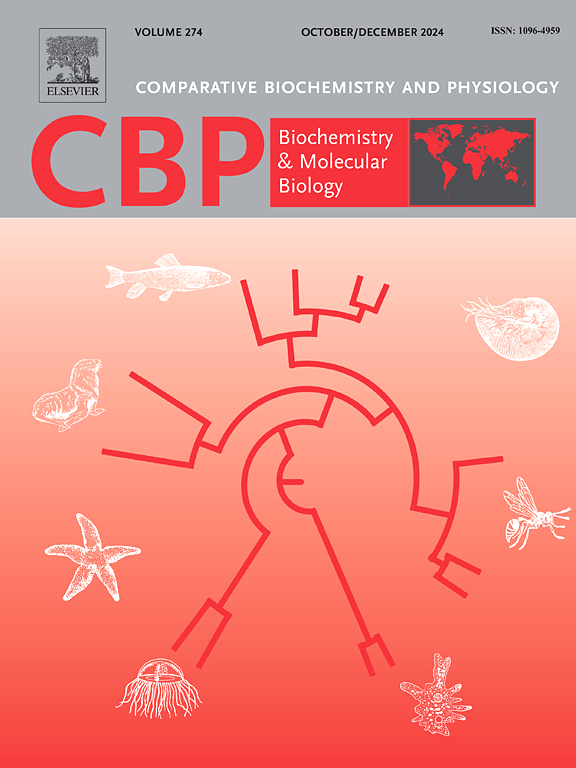Characterization of myostatin genes in Black Sea trout, Salmo labrax, and their differential responses to high temperature and starvation stressors
IF 1.8
3区 生物学
Q4 BIOCHEMISTRY & MOLECULAR BIOLOGY
Comparative Biochemistry and Physiology B-Biochemistry & Molecular Biology
Pub Date : 2025-07-21
DOI:10.1016/j.cbpb.2025.111136
引用次数: 0
Abstract
The identification of myostatin (mstn) gene functions in salmonids has been complicated by two whole-gene duplications (WGDs), leading to the presence of up to four mstn genes in their genomes, as opposed to the one or two copies found in other vertebrates. In this research, we molecularly cloned and characterized four mstn genes—Sl-mstna1, Sl-mstna2, Sl-mstnb1, and Sl-mstnb2—in the Black Sea trout (Salmo labrax). We propose that Sl-mstnb2 is a pseudogene due to a nonfunctionalization event, while Sl-mstna1, Sl-mstna2, and Sl-mstnb1 are retained in the Salmo labrax genome due to subfunctionalization. Notably, the expression level of the Sl-mstna1 and Sl-mstna2 genes varied across different tissues, implying divergent regulatory mechanisms. Starvation and high temperature increased mRNA expression of Sl-mstna1 and Sl-mstna2, while Sl-mstnb1 transcription was decreased by both stress factors. The tissue-specific transcription and modulation of Sl-mstnb1 were distinctly different from those of the Sl-mstna duplicates, suggesting functional divergence between the Sl-mstna and Sl-mstnb1 genes.

黑海鳟鱼肌肉生长抑制素基因的特征及其对高温和饥饿胁迫的差异反应
鲑鱼中肌生长抑制素(mstn)基因功能的鉴定由于两次全基因复制(WGDs)而变得复杂,导致它们的基因组中存在多达四个mstn基因,而在其他脊椎动物中发现的是一个或两个拷贝。本研究在黑海鳟鱼(Salmo labrax)中克隆并鉴定了4个mstn基因sl -mstna1、Sl-mstna2、Sl-mstnb1和sl -mstnb2。我们认为Sl-mstnb2是由于非功能化事件导致的假基因,而Sl-mstna1、Sl-mstna2和Sl-mstnb1由于亚功能化而保留在Salmo labrax基因组中。值得注意的是,Sl-mstna1和Sl-mstna2基因在不同组织中的表达水平存在差异,表明其调控机制存在差异。饥饿和高温使Sl-mstna1和Sl-mstna2的mRNA表达升高,而Sl-mstnb1的转录水平均降低。Sl-mstnb1的组织特异性转录和调控与Sl-mstna重复序列的组织特异性转录和调控明显不同,表明Sl-mstna和Sl-mstnb1基因在功能上存在差异。
本文章由计算机程序翻译,如有差异,请以英文原文为准。
求助全文
约1分钟内获得全文
求助全文
来源期刊
CiteScore
4.60
自引率
4.50%
发文量
77
审稿时长
22 days
期刊介绍:
Comparative Biochemistry & Physiology (CBP) publishes papers in comparative, environmental and evolutionary physiology.
Part B: Biochemical and Molecular Biology (CBPB), focuses on biochemical physiology, primarily bioenergetics/energy metabolism, cell biology, cellular stress responses, enzymology, intermediary metabolism, macromolecular structure and function, gene regulation, evolutionary genetics. Most studies focus on biochemical or molecular analyses that have clear ramifications for physiological processes.

 求助内容:
求助内容: 应助结果提醒方式:
应助结果提醒方式:


